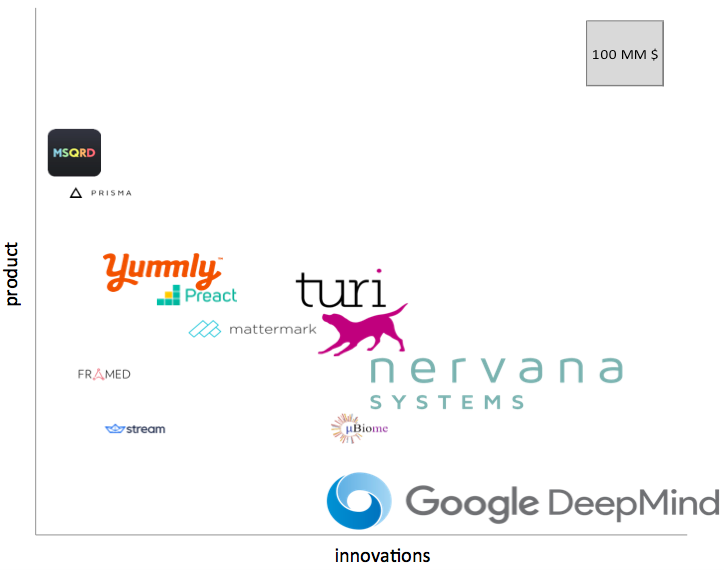I was on Data Fest at Yandex on 10-11 of September and we discussed machine learning startups on last 3 lectures. Main idea was that there are 2 factors of success: you need to have innovations and product. The post below is just to analyse and summarise these two factors of success.
Startups
If we are talking about startups, under “innovations” we assume high tech advanced tools, under “product” - a tool, which can provide benefit for customers.
In order to visualise this idea I draw a scatterplot, when X is for “innovations”, Y - product, size of the icon is for value of the startup. (I don’t mind telling, Gartner have similar idea, however the chart below is just more suitable for startups). The coordinates are pretty subjective. While developing this scatterplot I tried to stick to following rules: if you have a breakthrough machine learning technology, you will be in righ part of the plot. If you have large customers base, high NPS or “network effect”, you will be on the top of the chart.

Let’s start with Prisma. It’s an app which turns your photos into artworks. The app has an algorithm which was developed before Prisma a year ago, so almost no innovations. However its “network effect” was large.
On the other side is Google DeepMind, which is the only expensive startup without product, but with breakthrough machine learning technology.
Some more exmples:
Turi - specialized in providing tools and frameworks for other developers to incorporate machine learning and artificial intelligence into their apps;
Preact - cloud-based, automatic customer success service that helps subscription software companies maximize customer lifetime value by reducing churn, acquiring new customers, and driving upsells;
Nervana - provides artificial intelligence for cloud computing;
uBiome - data science from Bacteria;
Stream - is a new kind of data store designed for building, scaling and personalising feeds;
Yummly - data science for personal taste;
Granify - knows which shoppers aren’t going to buy and changes their minds.
People
Startups are done by people and the position of a startup on the scatterplot above is defined by people. Separate people are vectors on Innovations-Product scatterplot. And if people unite in order to build startup, they sum their vectors.
If we are talking about people, under “innovations” we assume breakthrough researches and decisions. And “product” is the ability to administrate, integrate and deliver results. These factors were presented in the book “The Ideal Executive: Why You Cannot Be One and What to Do About It, A New Paradigm for ManagementThe Ideal Executive: Why You Cannot Be One and What to Do About It, A New Paradigm for Management” by Ichak Kalderon. However I separated innovations due to high tech industry speciality. In high tech industry it is more common to meet 2 kinds of people: antisocial geniuses able to develop new algorithms and product/sales guys.
Below is the canonical example of two Steves - Wozniak and Jobs. Here you see two multidirectional vectors united by common idea and resulting huge footprint in the history.

Summary
To sum it up, you need to concentrate on your vector and try to extend it further. Herewith you need to find someone who can complement your vector and pull your startup. Unless you were born Elon Musk, of course.